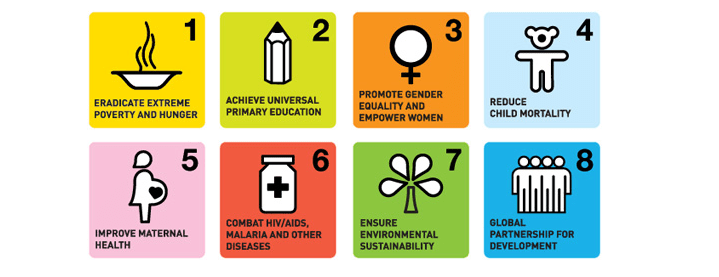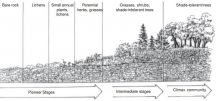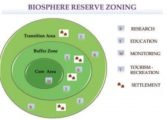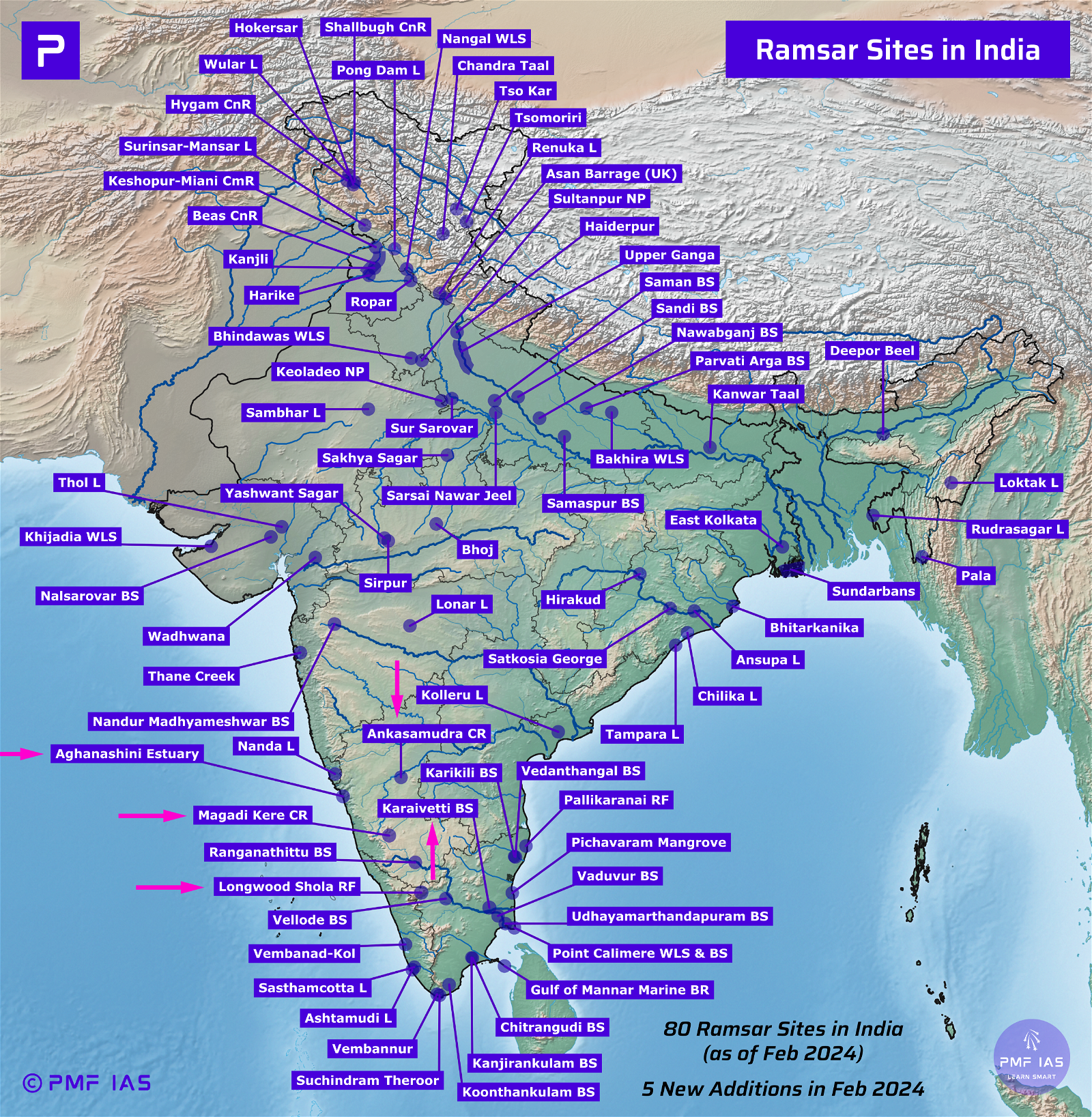
Earth Summit 1992, UN Environment, Rio+20, CBD, UNFCCC
Subscribe to Never Miss an Important Update! Assured Discounts on New Products!
Must Join PMF IAS Telegram Channel & PMF IAS History Telegram Channel
Nature conservation
Hazardous material (explained in in “Solid Waste”)
Land
Marine environment
Atmosphere
|
United Nations Conference on the Human Environment (1972)
- The United Nations Conference on the Human Environment was first held in Stockholm, Sweden, in 1972.
- It marked the emergence of international environmental law.
Stockholm Declaration
- It is also known as The Declaration on the Human Environment.
- It set out the principles for various international environmental issues, natural resource management, pollution prevention and the relationship between the environment and development.
United Nations Environment Programme (UNEP) or UN Environment
- UNEP is an agency of the United Nations.
- It coordinates the UN’s environmental activities.
- It assists developing countries in implementing environmentally sound policies and practices.
- It was founded as a result of the United Nations Conference on the Human Environment 1972.
- It has overall responsibility for environmental problems among United Nations agencies.
- Addressing climate change or combating desertification, are overseen by other UN organizations, like the UNFCCC and the United Nations Convention to Combat Desertification.
- UNEP’s activities cover a wide range of issues regarding the atmosphere, marine and terrestrial ecosystems, environmental governance and green economy.
- The World Meteorological Organization and UN Environment established the Intergovernmental Panel on Climate Change (IPCC) in 1988.
- UN Environment is also one of several Implementing Agencies for the Global Environment Facility (GEF) and the Multilateral Fund for the Implementation of the Montreal Protocol.
- It is also a member of the United Nations Development Group.
- UNEP has registered several successes, such as the 1987 Montreal Protocol, and the 2012 Minamata Convention, a treaty to limit toxic mercury.
- UNEP has sponsored the development of solar loan programmes.
- The solar loan programme sponsored by UN Environment helped finance solar power systems in India.
Intergovernmental Panel on Climate Change (IPCC)
- IPCC is a scientific intergovernmental body under the auspices of the United Nations.
- It was first established in 1988 by two United Nations organizations, the World Meteorological Organization (WMO) and the United Nations Environment Programme (UNEP).
- Membership of the IPCC is open to all members of the WMO and UNEP.
- The IPCC produces reports that support the UNFCCC.
- IPCC reports cover all relevant information to understand the risk of human-induced climate change, its potential impacts and options for adaptation and mitigation.
- The IPCC does not carry out its own original research.
- Thousands of scientists and other experts contribute on a voluntary basis.
- The 2007 Nobel Peace Prize was shared, in two equal parts, between the IPCC and an American Environmentalist.
The aims of the IPCC are to assess scientific information relevant to:
- Human-induced climate change,
- The impacts of human-induced climate change,
- Options for adaptation and mitigation.
IPCC Assessment Reports (AR)
- In accordance with its mandate, the IPCC prepares at regular intervals comprehensive Assessment Reports of scientific, technical and socio-economic information relevant for the understanding of human induced climate change, potential impacts of climate change and options for mitigation and adaptation.
Special Reports
- Special Reports have been prepared on topics such as aviation, regional impacts of climate change, technology transfer, emissions scenarios, land use, land use change and forestry, carbon dioxide capture and storage and on the relationship between safeguarding the ozone layer and the global climate system.
Conservation of Migratory Species
- Full name: The Convention on the Conservation of Migratory Species of Wild Animals.
- Convention on Migratory Species or the Bonn Convention or Global Wildlife conference.
- It is an international treaty, concluded under the aegis of the United Nations Environment Programme.
- The Convention was signed in 1979 in Bonn, Germany and entered into force in 1983.
- The CMS is the only global and UN-based intergovernmental organization established exclusively for the conservation and management of terrestrial, aquatic and avian migratory species throughout their range.
Global Environment Facility
- The Global Environment Facility (GEF) unites 183 countries in partnership with international institutions, civil society organizations (CSOs), and the private sector to address global environmental issues while supporting national sustainable development initiatives.
- An independently operating financial organization, the GEF provides grants for projects related to biodiversity, climate change, international waters, land degradation, the ozone layer, and persistent organic pollutants.
The GEF also serves as financial mechanism for the following conventions:
- Convention on Biological Diversity (CBD)
- United Nations Framework Convention on Climate Change (UNFCCC)
- UN Convention to Combat Desertification (UNCCD)
- Stockholm Convention on Persistent Organic Pollutants (POPs)
- Minamata Convention on Mercury
- The GEF, although not linked formally to the Montreal Protocol on Substances that Deplete the Ozone Layer (MP), supports implementation of the Protocol in countries with economies in transition.
The GEF works with18 agencies. Notable ones among them are:
- United Nations Development Programme
- United Nations Environment
- World Bank
- Food and Agriculture Organization
- Asian Development Bank
- International Fund for Agricultural Development
- World Wildlife Fund – US
- Conservation International
- International Union for Conservation of Nature (IUCN)
Areas of work
- Biodiversity, Climate change, International waters, Land degradation, Sustainable forest management / REDD+ and Ozone depletion
Q. With reference to ‘Global Environment Facility’, which of the following statements is/are correct?
- It serves as financial mechanism for ‘Convention on Biological Diversity’ and ‘United Nations Framework Convention on Climate Change’.
- It undertakes scientific research on environmental issues at global level
- It is an agency under OECD to facilitate the transfer of technology and funds to underdeveloped countries with specific aim to protect their environment.
- Both (a) and (b)
Explanation:
- GEF is an independent financial organization.
- It may fund scientific research, but it is not directly involved in scientific research.
- IPCC takes care of most of the research work.
Answer: a)
UNCED or Earth Summit 1992, Rio De Janeiro Brazil
- Earth Summit 1992 is also known as The United Nations Conference on Environment and Development (UNCED).
- Earth Summit 1992 succeeded in raising public awareness of the need to integrate environment and development.
- 190 countries pledged their commitment to achieve by 2010, a significant reduction in the current rate of biodiversity loss at global, regional and local levels.
- As a follow-up, the World Summit on Sustainable Development (Rio+10) was held in 2002 in Johannesburg, South Africa.
- In 2012, the United Nations Conference on Sustainable Development was also held in Rio and is also commonly called Rio+20 or Rio Earth Summit 2012.
The issues touched included:
- checking production of toxic components, such as lead in gasoline, or poisonous waste including radioactive chemicals,
- alternative sources of energy to replace the use of fossil fuels,
- new reliance on public transportation systems in order to reduce vehicle emissions, congestion in cities,
- the health problems caused by polluted air and smoke, and
- the growing usage and limited supply of water.
Q. What is Rio+20 Conference, often mentioned in the news?
- It is the United nations Conference on Sustainable Development
- It is a Ministerial Meeting of the World Trade Organization
- It is a Conference of the Inter-governmental Panel on Climate Change
- It is a Conference of the Member Countries of the Convention on Biological Diversity
Answer: a) United nations Conference on Sustainable Development
The Earth Summit resulted in the following documents:
- Rio Declaration: principles intended to guide countries in future sustainable development.
- Agenda 21: non-binding action plan of the United Nations with regard to sustainable development.
- Forest Principles: Non-legally binding document on Conservation and Sustainable Development of All Types of Forests.
Landmark Agreements
- An important achievement of the summit was an agreement on the Climate Change Convention which in turn led to the Kyoto Protocol and the Paris Agreement.
- Important legally binding agreements (Rio Convention) were opened for signature:
- Convention on Biological Diversity.
- United Nations Convention to Combat Desertification.
Agenda 21
- Agenda 21 is a non-binding action plan of the United Nations (UN) related to sustainable development.
- It was an outcome of the Earth Summit 1992.
- The number 21 refers to an agenda for the 21st century.
- Its aim is achieving global sustainable development.
- Since 2015, Sustainable Development Goals are included in the Agenda 2030.
Q. With reference to ‘Agenda 21’, sometimes seen in the news, consider the following statements: (2016)
- It is a global action plan for sustainable development
- It originated in the World Summit on Sustainable Development held in Johannesburg in 2002.
Which of the statements given above is/are correct?
- 1 only
- 2 only
- Both 1 and 2
- Neither 1 nor 2
Answer: a) 1 only
United Nations Convention to Combat Desertification (UNCCD)
- The Convention stemmed from a direct recommendation of the Rio Conference’s Agenda 21 in 1994.
- UNCCD is a Convention to combat desertification and mitigate the effects of drought through national action programs (NAP).
- National action programs (NAP) incorporate long-term strategies supported by international cooperation.
- It is the only internationally legally binding framework set up to address desertification.
- It was adopted in Paris, France in 1994 and entered into force in 1996.
- It has 196 parties, making it truly global in reach.
- 2006 was declared “International Year of Deserts and Desertification”.
- The UN Convention to Combat Desertification has established a Committee on Science and Technology (CST).
- CST is composed of government representatives competent in the fields of expertise relevant to combating desertification and mitigating the effects of drought.
- UNCCD collaborates closely with Convention on Biological Diversity (CBD).
Q. What is/are the importance(s) of the ‘United Nations Convention to Combat Desertification’?
- It aims to promote effective action through innovative national programs and supportive inter-national partnerships.
- It has a special/particular focus on South Asia and North Africa regions, and its Secretariat facilitates the allocation of major portion of financial resources to these regions.
- It is committed to bottom-up approach, encouraging the participation of local people in combating the desertification.
Select the correct answer using the code given below.
- 1 only
- 2 and 3 only
- 1 and 3 only
- 1, 2 and 3
Answer: c) 1 and 3 only
Rio+5 (1997)
- In 1997, the UN General Assembly held a special session to appraise the status of Agenda 21 (Rio +5).
- The Assembly recognized progress as “uneven” and identified key trends, including increasing globalization, widening inequalities in income, and continued deterioration of the global environment.
Rio+10 (2002) or Earth Summit 2002
- Rio+10 (2002) or Earth Summit 2002 or World Summit on Sustainable Development.
- Took place in Johannesburg, South Africa in 2002.
- Rio+10 affirmed UN commitment to Agenda 21, alongside the Millennium Development Goals.
- Johannesburg Declaration: committing the nations of the world to sustainable development.
Rio+20 (2012)
- Rio+20 (2012) or United Nations Conference on Sustainable Development.
- Rio+20 was a 20-year follow-up to the Earth Summit 1992 and 10-year follow-up to the Earth Summit 2002.
- It is also known as Rio 2012 or Earth Summit 2012.
- Hosted by Brazil in Rio de Janeiro in 2012.
- It reaffirmed the commitment to Agenda 21.
- It was the third international conference on sustainable development.
- Earth Summit 1992 (Rio de Janeiro) = UN Conference on Environment and Development (UNCED)
- Earth Summit 2002 (Johannesburg) = World Summit on Sustainable Development (WSSD)
- Earth Summit 2012 (Rio de Janeiro) = UN Conference on Sustainable Development (UNCSD)
PAGE, launched in 2013, is a direct response to the Rio+20 Declaration, The Future We Want.Partnership for Action on Green Economy (PAGE)
- Rio+20 Declaration called upon the UN system and the international community to aid interested countries in developing, adopting and implementing green economy policies and strategies.
- PAGE supports nations in reframing economic policies and practices around sustainability.
- PAGE seeks to assist countries in achieving SDG (2030 Agenda), especially SDG 8: “Promote sustained, inclusive and sustainable economic growth, full and productive employment.”
- PAGE brings together the expertise of five UN agencies – UNEP, ILO, UNIDO, UNDP and UNITAR.
ILO: International Labour Organization
UNIDO: UN Industrial Development Organization
UNITAR: UN Institute for Training and Research.
Q. The Partnership for Action on Green Economy (PAGE), a UN mechanism to assist countries transition towards greener and more inclusive economies, emerged at (2018)
- The Earth Summit on Sustainable Development 2002, Johannesburg
- The United Nations Conference on Sustainable Development 2012, Rio de Janeiro
- The United Nations Framework Convention on Climate Change 2015, Paris
- The World Sustainable Development Summit 2016, New Delhi
2030 Agenda – Sustainable Development Goals (SDGs)
- The UN 2030 Agenda for Sustainable Development was launched in 2015.
- The UN 2030 Agenda’s Sustainable Development Goals (SDG) aim at eradicating poverty in all forms and “seek to realize the human rights of all and achieve gender equality”.
- The Sustainable Development Goals (SDGs) are a collection of 17 global goals, and their 169 targets, set by the United Nations General Assembly in 2015 for the year 2030 (UNGA resolution “2030 Agenda”).
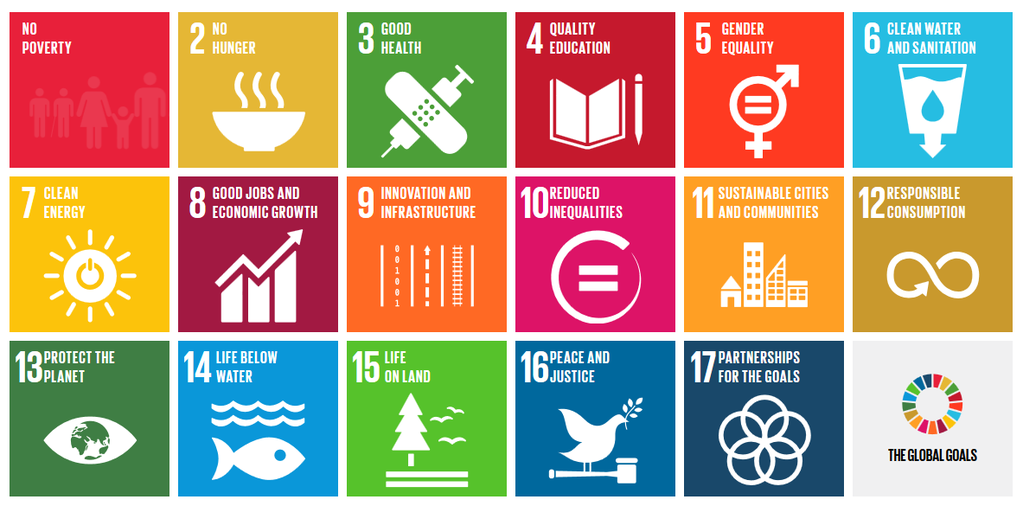
Q8. Consider the following statements: (2016)
- The Sustainable Development Goals were first proposed in 1972 by a global think tank called the ‘Club of Rome’.
- The Sustainable Development Goals have to be achieved by 2030.
Which of the statements given above is/are correct?
- 1 only
- 2 only
- Both 1 and 2
- Neither 1 nor 2
Answer: b) 2 only
Goal 2: Zero hunger
“End hunger, achieve food security and improved nutrition, and promote sustainable agriculture”.
- This would be accomplished by
- doubling agricultural productivity and incomes of small-scale food producers (women and indigenous peoples), by
- ensuring sustainable food production systems, and by
- progressively improving land and soil quality.
- Other targets deal with maintaining genetic diversity of seeds, increasing access to land, preventing trade restriction and distortions in world agricultural markets, eliminating wastage and ending malnutrition.
Goal 6: Clean water and sanitation
“Ensure availability and sustainable management of water and sanitation for all.”
- Safe drinking water and hygienic toilets.
- Toilets in schools and work places.
- Equitable sanitation for addressing the specific needs of women and girls, disabled, aged persons.
Goal 7: Affordable and clean energy
“Ensure access to affordable, reliable, sustainable and modern energy for all.”
- 2030 target: access to affordable and reliable energy while increasing the share of renewable energy.
Goal 11: Sustainable cities and communities
“Make cities and human settlements inclusive, safe, resilient, and sustainable.”
- 2030 target is to ensure access to safe and affordable housing.
Goal 12: Responsible consumption and production
“Ensure sustainable consumption and production patterns.”
- The targets of Goal 12 include:
- using eco-friendly production methods
- reducing the amount of waste.
- Increase national recycling rates.
Goal 13: Climate action
“Take urgent action to combat climate change and its impacts by regulating emissions and promoting developments in renewable energy.”
Goal 14: Life below water
“Conserve and sustainably use the oceans, seas and marine resources for sustainable development.”
- The targets include
- preventing and reducing marine pollution and acidification,
- protecting marine and coastal ecosystems and regulating fishing.
|
Goal 15: Life on Land
“Protect, restore and promote sustainable use of terrestrial ecosystems, sustainably manage forests, combat desertification, and halt and reverse land degradation and halt biodiversity loss.”
- Goal 15 calls for more attention to preventing invasion of introduced species and more protection of endangered species.
Millennium Development Goals
Millennium Development Goals by 2015
Transition to green economy
Measures to adapt green economy
Moving towards a green economy has the potential to achieve sustainable development. |
Convention on Biological Diversity
- Biodiversity conservation is a collective responsibility of all nations.
- Convention on Biological Diversity (CBD) is a step towards conserving biological diversity or biodiversity with the involvement of the entire world.
- The Convention on Biological Diversity (a multilateral treaty) was opened for signature at the Earth Summit in Rio de Janeiro in 1992 and entered into effect in 1993.
- The convention called upon all nations to take appropriate measures for conservation of biodiversity and sustainable utilisation of its benefits.
- The Convention has three main goals:
- conservation of biological diversity (or biodiversity);
- sustainable use of its components; and
- fair and equitable sharing of benefits arising from genetic resources.
- It is often seen as the key document regarding sustainable development.
- The Convention is legally binding; countries that join it (‘Parties’) are obliged to implement its provisions.
- 195 UN states and the European Union are parties to the convention.
- All UN member states, with the exception of the United States, have ratified the treaty.
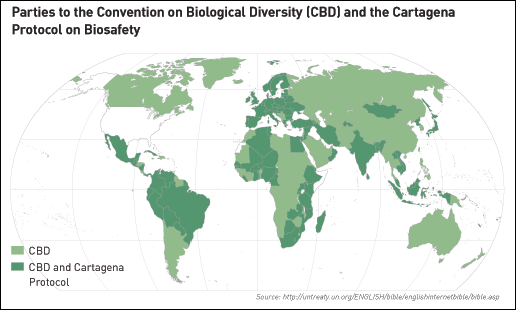
- At the 2010 10th Conference of Parties (COP) to the Convention on Biological Diversity in October in Nagoya, Japan, the Nagoya Protocol was adopted.
Cartagena Protocol
- CBD covers the rapidly expanding field of biotechnology through its Cartagena Protocol on Biosafety.
- It addresses technology development and transfer, benefit-sharing and biosafety issues.
- The Biosafety Protocol seeks to protect biological diversity from the potential risks posed by living modified organisms resulting from modern biotechnology.
Nagoya Protocol
- It is the second Protocol to the CBD; the first is the 2000 Cartagena Protocol on Biosafety.
- It is a 2010 supplementary agreement to the 1992 Convention on Biological Diversity (CBD).
- The Nagoya Protocol is about “Access to Genetic Resources and the Fair and Equitable Sharing of Benefits Arising from their Utilization”, one of the three objectives of the CBD.
Q. Consider the following pairs (2016):
| Terms sometimes seen in the news | Their origin |
| 1. Annex-I Countries | Cartagena Protocol |
| 2. Certified Emissions Reductions | Nagoya Protocol |
| 3. Clean Development Mechanism | Kyoto Protocol |
Which of the pairs given above is/are correctly matched?
- 1 and 2 only
- 2 and 3 only
- 3 only
- 1, 2 and 3
Explanation:
- Annex-I Countries, Clean Development Mechanism, Certified Emission Reductions (CERs) or carbon credits Kyoto Protocol.
Answer: c) 3 only
UNFCCC: United Nations Framework Convention on Climate Change
- International environmental treaty that came into existence under the aegis of UN.
- UNFCCC is negotiated at the Earth Summit 1992.
- Signed in 1992, New York City.
- As of March 2019, UNFCCC has 197 parties.
- Role: UNFCCC provides a framework for negotiating specific international treaties (called “protocols”) that aim to set binding limits on greenhouse gases.
- Objective of UNFCCC: Stabilize greenhouse gas concentrations in the atmosphere at a level that would prevent dangerous consequences.
- Legal Effect: Treaty is considered legally non-binding.
- The treaty itself sets no binding limits on greenhouse gas emissions for individual countries.
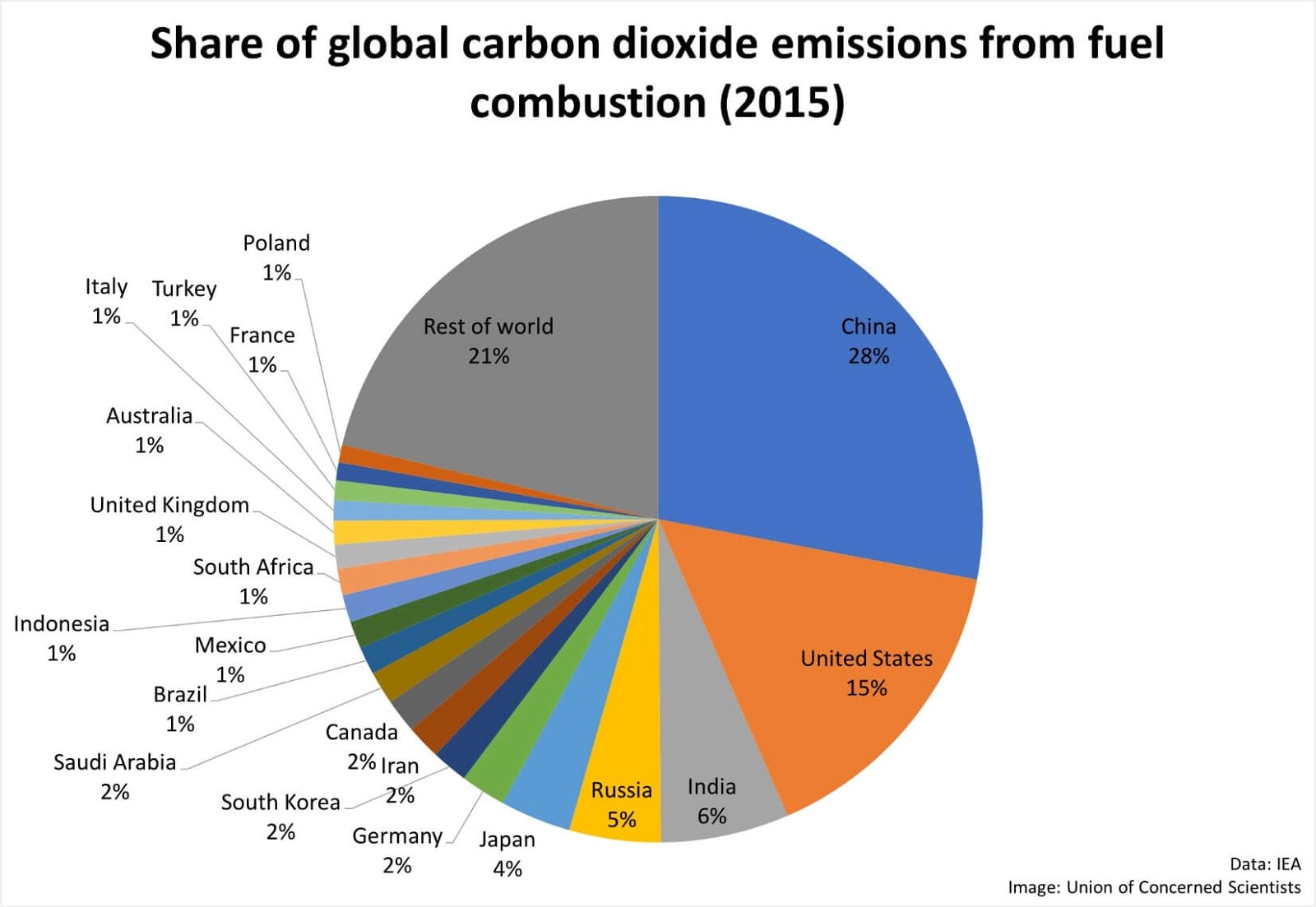
Credits: UCSUSA
Conferences of the Parties (COP) – UNFCCC
- The COP is the decision-making body of UNFCCC.
- All States that are Parties to the Convention are represented at the COP.
- They review the implementation of any legal instruments that the COP adopts.
- They promote the effective implementation of the Convention.
- The first COP meeting was held in Berlin, Germany in March 1995.
- The parties to the convention have met annually since 1995.
- In 1997, the Kyoto Protocol (3rd COP) was concluded and established legally binding obligations for developed countries to reduce their greenhouse gas emissions.
- COP 21 (2015) was held in Paris in 2015.
- COP 22 (2016) was held at Marrakesh, Morocco.
- COP 23 (2017) was held at Bonn, Germany.
- COP 24 (2018) was held at Katowice, Poland.
- COP 25 (2019) will be held at Santiago, Chile during Nov-Dec 2019.
List of UNFCCC Summits
- 1995: COP 1, The Berlin Mandate
- 1996: COP 2, Geneva, Switzerland
- 1997: COP 3, The Kyoto Protocol on Climate Change
- 1998: COP 4. Buenos Aires, Argentina
- 1999: COP 5, Bonn, Germany
- 2000: COP 6. The Hague. Netherlands
- 2001: COP 6, Bonn. Germany
- 2001: COP 7. Marrakech, Morocco
- 2002: COP 8, New Delhi, India
- 2003: COP 9, Milan, Italy
- 2004: COP 10. Buenos Aires. Argentina
- 2005: COP 11/CMP 1. Montreal, Canada Montreal, (Kyoto Protocol was ratified in 2005)
- 2006: COP 12/CMP 2, Nairobi. Kenya
- 2007: COP 13/CMP 3, Bali, Indonesia
- 2008: COP 14/CMP 4, Poznan. Poland
- 2009: COP 15/CMP 5, Copenhagen, Denmark
- 2010: COP 16/CMP 6, Canciin, Mexico
- 2011: COP 17/CMP 7, Durban, South Africa
- 2012: COP 18/CMP 8, Doha, Qatar
- 2013: COP 19/CMP 9, Warsaw, Poland
- 2014: COP 20/CMP 10. Lima, Peru
- 2015: COP 21/CMP 11, Paris, France
- 2016: COP 22/CMP 12, Marrakech, Morocco
- 2017: COP 23/CMP 13, Bonn, Germany.
- 2018: COP 24/CMP 14, Katowice, Poland.
Criticisms of the UNFCCC
- Nothing except Kyoto Protocol made any binding limits on GHG emissions.
- Never achieved its stated goals of reducing the emission of carbon dioxide.
- Negotiations are governed by consensus and small group of countries often block the negotiations.
- It is easy for the developed countries to escape from their responsibility: United States, one of the biggest polluters never ratified Kyoto Protocol.
- Canada pulled out of Kyoto Protocol citing wealth transfers out the country due to binding limits.
- Treaty doesn’t cover developing countries who now include the largest CO2 emitters (India and China).
- Japan, Russia didn’t sign second Kyoto term because it would impose restrictions on it not faced by its main economic competitors, China, India and Indonesia.






